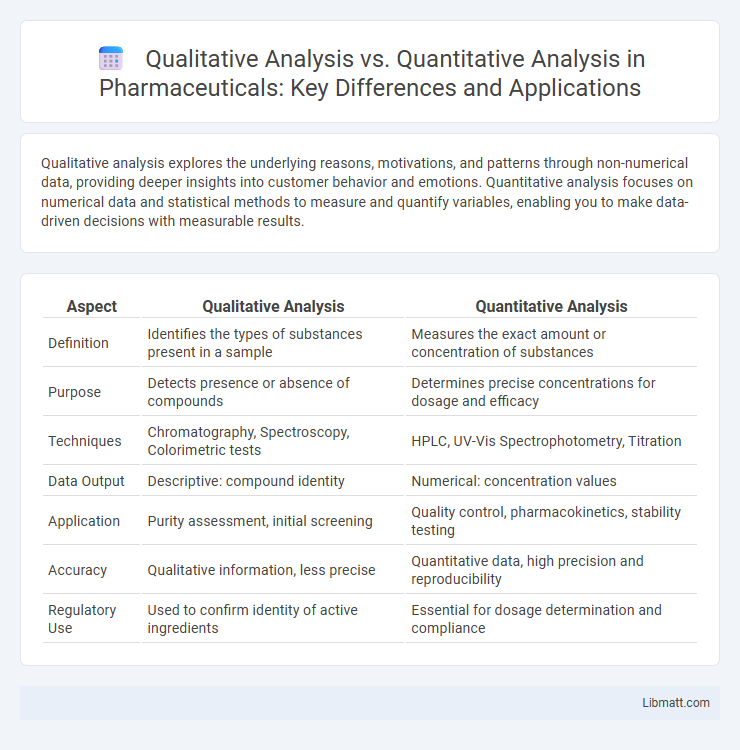Qualitative analysis explores the underlying reasons, motivations, and patterns through non-numerical data, providing deeper insights into customer behavior and emotions. Quantitative analysis focuses on numerical data and statistical methods to measure and quantify variables, enabling you to make data-driven decisions with measurable results.
Table of Comparison
| Aspect | Qualitative Analysis | Quantitative Analysis |
|---|---|---|
| Definition | Identifies the types of substances present in a sample | Measures the exact amount or concentration of substances |
| Purpose | Detects presence or absence of compounds | Determines precise concentrations for dosage and efficacy |
| Techniques | Chromatography, Spectroscopy, Colorimetric tests | HPLC, UV-Vis Spectrophotometry, Titration |
| Data Output | Descriptive: compound identity | Numerical: concentration values |
| Application | Purity assessment, initial screening | Quality control, pharmacokinetics, stability testing |
| Accuracy | Qualitative information, less precise | Quantitative data, high precision and reproducibility |
| Regulatory Use | Used to confirm identity of active ingredients | Essential for dosage determination and compliance |
Introduction to Qualitative and Quantitative Analysis
Qualitative analysis focuses on understanding phenomena through non-numerical data such as interviews, observations, and textual analysis, emphasizing context and meaning. Quantitative analysis involves the systematic examination of numerical data using statistical methods to identify patterns, relationships, and trends. Both approaches provide complementary insights, with qualitative analysis exploring depth and complexity, while quantitative analysis offers measurement and generalization.
Core Principles of Qualitative Analysis
Qualitative analysis centers on understanding human behavior, motivations, and experiences through non-numerical data like interviews, observations, and textual content. It emphasizes depth over breadth, exploring themes, patterns, and meanings to provide rich, contextualized insights. Your research benefits from qualitative methods when seeking to interpret complex social phenomena or generate hypotheses for further quantitative testing.
Key Features of Quantitative Analysis
Quantitative analysis emphasizes numerical data, statistical methods, and measurable variables to identify patterns and test hypotheses with high precision. It relies on structured tools such as surveys, experiments, and quantitative modeling to produce replicable and objective results. The approach prioritizes large sample sizes, scalability, and the use of statistical software for data interpretation and visualization.
Data Collection Methods Compared
Qualitative analysis utilizes methods such as interviews, focus groups, and open-ended surveys to collect in-depth, subjective data that captures personal experiences and emotions. Quantitative analysis relies on structured techniques like online surveys, experiments, and statistical sampling to gather numerical data for measurable and generalizable results. Choosing the appropriate data collection method depends on your research goals, whether you seek rich, contextual insights or precise, statistical evidence.
Types of Data: Qualitative vs. Quantitative
Qualitative analysis involves non-numeric data such as interviews, observations, and open-ended survey responses that capture themes, patterns, and meanings. Quantitative analysis uses numeric data from sources like experiments, surveys with closed-ended questions, and statistical reports to measure variables and test hypotheses. Qualitative data emphasizes context and depth, while quantitative data prioritizes precision and generalizability through statistical methods.
Analytical Techniques and Tools
Qualitative analysis employs techniques such as thematic coding, content analysis, and ethnographic methods to interpret non-numerical data, using tools like NVivo and Atlas.ti for pattern recognition and narrative development. Quantitative analysis relies on statistical methods, including regression analysis, hypothesis testing, and descriptive statistics, supported by software like SPSS, R, and Excel for numerical data processing and visualization. Your choice between these analytical techniques and tools depends on whether your research aims to explore subjective experiences or to quantify measurable variables.
Strengths and Limitations of Each Approach
Qualitative analysis excels in exploring complex phenomena and providing in-depth insights into behaviors, motivations, and experiences, but it often lacks statistical generalizability and can be time-consuming. Quantitative analysis offers measurable data and statistical validation, enabling broad generalizations and pattern identification, yet it may oversimplify nuanced contexts and overlook subjective meanings. Balancing both approaches allows for comprehensive research by leveraging qualitative depth and quantitative precision.
When to Use Qualitative or Quantitative Analysis
Qualitative analysis is best used when exploring complex phenomena, understanding motivations, behaviors, and gaining in-depth insights through methods like interviews, focus groups, and observation. Quantitative analysis is ideal for testing hypotheses, measuring variables, and producing statistically significant results using surveys, experiments, or numerical data sets. Selecting the appropriate method depends on research objectives: use qualitative for exploratory, open-ended questions and quantitative for precise, measurable outcomes.
Integrating Both Methods: Mixed Methods Approaches
Integrating qualitative and quantitative analysis through mixed methods approaches combines the depth of qualitative insights with the statistical power of quantitative data, enhancing research validity and comprehensiveness. These approaches utilize qualitative techniques such as interviews and focus groups alongside quantitative tools like surveys and experiments to provide a holistic understanding of research problems. Mixed methods improve data triangulation, allowing researchers to cross-verify findings and develop richer, contextualized interpretations.
Conclusion: Choosing the Right Analysis Method
Selecting the appropriate analysis method depends on your research goals and data type. Qualitative analysis provides in-depth insights into behaviors and motivations, ideal for exploratory studies, while quantitative analysis offers statistical validation and measurable outcomes suitable for hypothesis testing. Understanding these differences ensures your conclusions are accurate and actionable.
Qualitative analysis vs quantitative analysis Infographic

 libmatt.com
libmatt.com